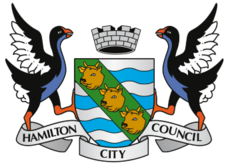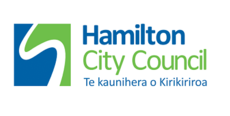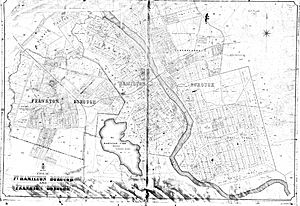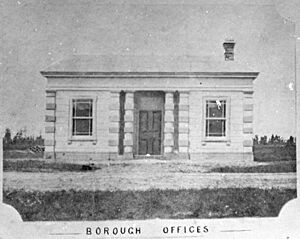Hamilton City Council (New Zealand) facts for kids
The Hamilton City Council (which in Māori is called Te kaunihera o Kirikiriroa) is like the local government for the city of Hamilton in New Zealand. It makes important decisions about how the city is run.
The council is led by the Mayor of Hamilton. Right now, the mayor is Paula Southgate. There are also 14 other people called councillors who help the mayor.
People in Hamilton vote for the mayor and councillors every three years.
How the Council is Made Up
The Hamilton City Council has 15 members in total. This includes the Mayor and 14 councillors. These councillors represent different parts of the city. These parts are called wards or areas.
There are three main wards:
- Maaori Ward: This ward covers the whole city. It has two councillors. Only people on the Māori electoral roll can vote for these councillors.
- East Ward: This ward covers the eastern half of the city. It has six councillors. People on the general electoral roll vote for these councillors.
- West Ward: This ward covers the western half of the city. It also has six councillors. People on the general electoral roll vote for these councillors.
The Waikato River acts as the boundary between the East and West wards.
Here are the people currently on the council:
| Mayor | Paula Southgate |
| Deputy Mayor | Angela O’Leary |
| Councillors – East Ward | Andrew Bydder Anna Casey Cox Mark Donovan Tim Macindoe Kesh Naidoo-Rauf Maxine van Oosten |
| Councillors – West Ward | Louise Hutt Emma Pike Angela O’Leary Geoff Taylor Sarah Thomson Ewan Wilson |
| Councillors – Maaori Ward | Melaina Huaki Moko Tauariki |
A Look Back: Hamilton Council's History
The Hamilton City Council we know today was created in 1989. This happened during a big change to local governments across New Zealand. Parts of Waikato and Waipā counties were added to the city area.
The original Hamilton town was much smaller. It was about 752 hectares (1,858 acres). Now, the city covers about 9,860 hectares (24,364 acres). This includes new areas like Rototuna, Rotokauri, and Peacocke, which were added in 1989. Temple View was also added in 2004.
Before the current council, there were many different groups that helped manage the area:
- The first local group was the Kirikiriroa Road Board. It started in 1868. This board looked after roads on the east side of the Waikato River.
- In 1871, the Hamilton West Highway District was set up. A similar group for Hamilton East followed soon after.
- The Hamilton Borough Council was first chosen by voters in 1878. This was a big step for local government.
- The Frankton Borough Council was formed in 1913. However, it joined with Hamilton in 1917 after people voted for it.
In 2019, a councillor named Phillip Yeung passed away. A special election was held in 2018 to choose a new councillor. Ryan Hamilton was elected to take his place.
In 2020, the way people vote for councillors changed. It moved from a system called "First Past the Post" to "Single Transferable Vote." Most people supported this change.
Where the Council Meets: Its Offices Over Time
The Hamilton Borough Council first met in a courthouse on Collingwood Street. In April 1878, they used a small house on Victoria Street as their council office. This building was later taken down in 1924. A hotel called the Novotel now stands in its place.
On March 23, 1905, a new town hall was opened. It cost £3,510 and had a special room for council meetings. This building was made bigger in 1914 but was later taken down in 1967.
On October 22, 1932, new offices made of strong concrete were opened on Alma Street. This brought all the council's offices together in one place. These offices cost £10,082. Radio station 1XH Hamilton even started broadcasting from the basement of these offices in 1949. Today, this building is protected as a heritage site and has several businesses in it.
In June 1960, the council moved into an even bigger building. It had four floors and two-story wings, including a library. This building was located between Anglesea, Caro, and Worley Streets. Later, another large section was added between 1980 and 1983.





